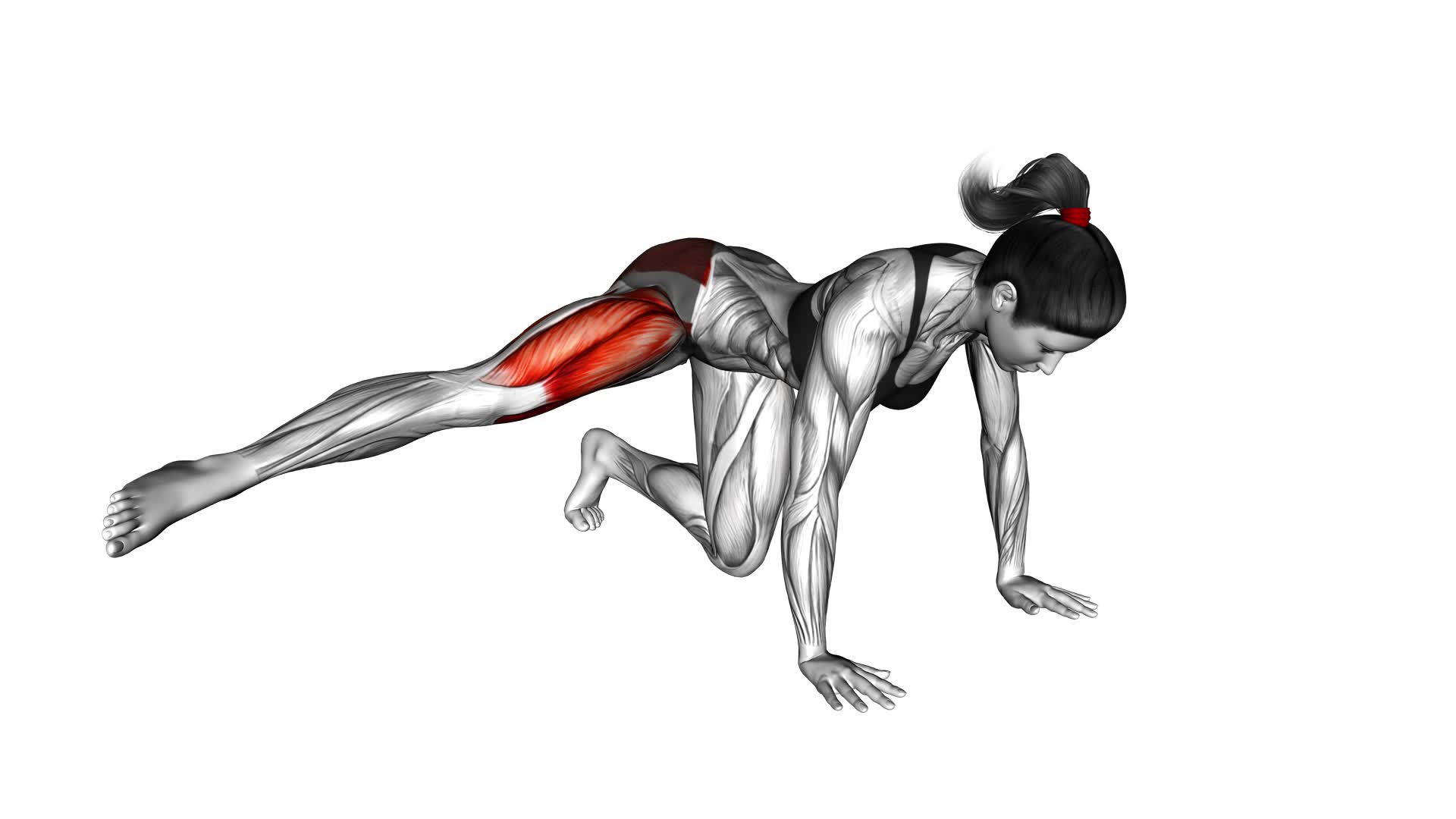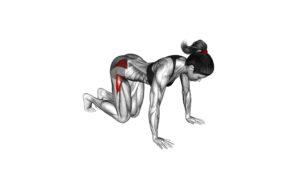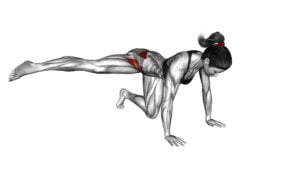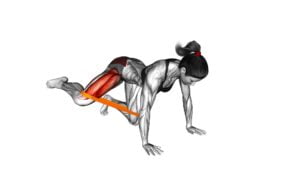Kneeling Side Leg to Kick (female) – Video Exercise Guide & Tips

Get ready to tone and strengthen your legs with the Kneeling Side Leg to Kick exercise! In this video exercise guide, we'll show you the proper technique and share tips for getting the most out of this move.
Watch This Exercise Video
Whether you're a beginner or advanced, we've got modifications for every fitness level. Avoid common mistakes and maximize your results with this effective exercise.
Let's kick it up a notch and achieve those leg goals!
Key Takeaways
- Kneeling Side Leg to Kick improves flexibility and strengthens the lower body.
- The exercise targets the glutes, inner and outer thighs, and hip muscles.
- It increases range of motion in the hips and overall flexibility.
- Kneeling Side Leg to Kick tones and strengthens the glutes for a firmer appearance.
Benefits of Kneeling Side Leg to Kick
To understand the benefits of the Kneeling Side Leg to Kick exercise, you should know that it helps improve flexibility and strengthen your lower body. This exercise specifically targets your glutes, inner and outer thighs, and hip muscles. By performing this exercise regularly, you can achieve a greater range of motion in your hips and improve overall flexibility.
Additionally, the Kneeling Side Leg to Kick exercise helps tone and strengthen your glutes, giving them a firmer and more sculpted appearance.
When you perform the Kneeling Side Leg to Kick exercise, you start by kneeling on the ground with your hands placed firmly on the floor in front of you. From this position, you lift one leg out to the side, keeping it straight and parallel to the floor. Then, you kick that leg forward, extending it as far as you can while maintaining proper form. This motion engages your glutes and thigh muscles, providing a challenging workout that promotes strength and tone.
Incorporating the Kneeling Side Leg to Kick exercise into your fitness routine can have numerous benefits. Not only will it help improve your flexibility, but it will also tone and strengthen your glutes, giving you a more defined lower body. By consistently performing this exercise, you can achieve your fitness goals and enjoy the physical benefits it provides.
Proper Technique for Kneeling Side Leg to Kick
To perform the Kneeling Side Leg to Kick exercise properly, begin by placing your hands firmly on the ground in front of you while kneeling. This exercise targets the hips, glutes, and outer thighs, improving overall lower body strength and stability.
Here are some important tips to ensure proper technique:
- Alignment and form in kneeling side leg to kick:
- Keep your back straight and core engaged throughout the exercise.
- Align your knees and hips with each other, maintaining a 90-degree angle.
- Lift your leg to the side, maintaining a straight line from your hip to your foot.
- Avoid leaning forward or backward, focusing on staying balanced and centered.
Breathing techniques during kneeling side leg to kick:
- Inhale deeply before you begin the movement.
- Exhale as you lift your leg, engaging your core and activating the muscles.
- Inhale as you lower your leg back down, maintaining control and stability.
- Remember to breathe steadily throughout the exercise to support your movements.
By paying attention to your alignment and form, as well as incorporating proper breathing techniques, you can maximize the effectiveness of the Kneeling Side Leg to Kick exercise and avoid unnecessary strain or injury.
Keep practicing and enjoy the benefits of this challenging exercise!
Tips for Getting the Most Out of Kneeling Side Leg to Kick
To maximize your results from the Kneeling Side Leg to Kick exercise, consistently incorporate it into your workout routine. Here are some tips to help you get the most out of this exercise.
Firstly, focus on your balance. Maintaining good balance is crucial for performing this exercise effectively. Engage your core muscles and keep your body aligned throughout the movement. This will help you stay stable and prevent any unnecessary strain on your joints.
Additionally, try incorporating variations of the Kneeling Side Leg to Kick for advanced practitioners. This will challenge your muscles in different ways and help you progress further. One variation is to add ankle weights to increase the resistance. Another variation is to perform the exercise on an unstable surface, such as a balance board or Bosu ball. This will further engage your core and challenge your balance.
Remember to start with lighter weights and gradually increase the resistance as you become more comfortable and confident with the exercise. This will help prevent injuries and ensure steady progress.
Modifications for Different Fitness Levels
To modify the Kneeling Side Leg to Kick exercise for different fitness levels, you can adjust the range of motion and resistance to suit your needs. Here are some modifications you can make:
- Modifications for beginners:
- Start with a smaller range of motion by not lifting your leg as high.
- Use a lighter resistance band or no resistance band at all.
- Focus on maintaining proper form and stability before increasing intensity.
- Variations for advanced practitioners:
- Increase the range of motion by lifting your leg higher and extending it further.
- Use a heavier resistance band or add ankle weights for added resistance.
- Incorporate additional challenges, such as adding a pulse at the top or holding the leg extended for a few seconds.
By adjusting the range of motion and resistance, you can tailor the Kneeling Side Leg to Kick exercise to your fitness level. This allows you to progress gradually and prevent injuries or strain.
Now let's move on to the next section where we'll discuss common mistakes to avoid during the kneeling side leg to kick.
Common Mistakes to Avoid During Kneeling Side Leg to Kick
To avoid common mistakes during the Kneeling Side Leg to Kick exercise, ensure that you maintain proper form and avoid these errors.
One common mistake isn't engaging your core muscles. It's important to keep your core muscles activated throughout the movement to stabilize your body and prevent any unnecessary strain on your lower back.
Another mistake to avoid is leaning too far forward or backward. This can throw off your balance and compromise the effectiveness of the exercise. Instead, focus on maintaining an upright posture throughout the movement.
Additionally, be mindful of your leg positioning. One common mistake is allowing your working leg to drift too far forward or backward. To maintain proper technique, keep your working leg in line with your body and avoid any excessive movements.
Finally, avoid rushing through the exercise. Take your time and focus on performing each repetition with control and precision.
Frequently Asked Questions
How Many Calories Can I Burn by Doing the Kneeling Side Leg to Kick Exercise?
You can burn calories by doing the kneeling side leg to kick exercise. It's an effective workout that targets your hips and legs.
However, the number of calories burned depends on various factors such as your weight, intensity, and duration of the exercise.
It's important to note that if you experience any hip joint discomfort while performing this exercise, you should consult a fitness professional or modify the movement to avoid injury.
Can the Kneeling Side Leg to Kick Exercise Help in Toning the Abdominal Muscles?
Yes, the kneeling side leg to kick exercise can definitely help in toning your abdominal muscles. This exercise requires engaging your core muscles to maintain stability while performing the leg kick. By repeatedly doing this movement, you're targeting and strengthening your abdominal muscles.
Additionally, this exercise also helps in improving flexibility as it stretches your hip flexors and increases your range of motion.
Incorporating this exercise into your routine will provide great benefits for your abs and flexibility.
Is It Normal to Feel Some Discomfort in the Hip Joint While Performing the Kneeling Side Leg to Kick Exercise?
Feeling some discomfort in your hip joint while doing the kneeling side leg to kick exercise isn't uncommon. It could be due to tightness or weakness in the hip muscles.
To avoid this, try modifying the exercise for beginners by reducing the range of motion or using a resistance band for support.
Remember to listen to your body and stop if the discomfort becomes too intense.
Always consult a professional if you have any concerns.
Can the Kneeling Side Leg to Kick Exercise Be Beneficial for Improving Flexibility?
The kneeling side leg to kick exercise can definitely benefit your flexibility. By targeting your hip and leg muscles, it helps to increase your range of motion and improve overall flexibility.
To get the most out of this exercise, make sure you maintain proper form and technique. Keep your core engaged, hips stable, and focus on lifting your leg as high as you comfortably can.
Consistency and proper execution will yield the best results.
How Frequently Should I Include the Kneeling Side Leg to Kick Exercise in My Workout Routine to See Results?
To see results from the kneeling side leg to kick exercise, you should include it in your workout routine with a frequency that matches your fitness goals. The effectiveness of this exercise depends on how often you perform it. Consistency is key.
Consider adding it to your routine 2-3 times a week for noticeable improvements in strength, flexibility, and overall lower body toning. Remember to listen to your body and gradually increase the intensity as you progress.
Conclusion
In conclusion, the kneeling side leg to kick exercise is a great way to strengthen and tone the muscles in your legs and hips.
By following the proper technique and incorporating these tips, such as engaging your core and maintaining proper form, you can maximize the benefits of this exercise.
Remember to start with modifications if needed and avoid common mistakes to ensure a safe and effective workout.
Incorporate this exercise into your routine to improve your overall lower body strength and stability.

Author
Years ago, the spark of my life’s passion ignited in my mind the moment I stepped into the local gym for the first time. The inaugural bead of perspiration, the initial endeavor, the very first surge of endorphins, and a sense of pride that washed over me post-workout marked the beginning of my deep-seated interest in strength sports, fitness, and sports nutrition. This very curiosity blossomed rapidly into a profound fascination, propelling me to earn a Master’s degree in Physical Education from the Academy of Physical Education in Krakow, followed by a Sports Manager diploma from the Jagiellonian University. My journey of growth led me to gain more specialized qualifications, such as being a certified personal trainer with a focus on sports dietetics, a lifeguard, and an instructor for wellness and corrective gymnastics. Theoretical knowledge paired seamlessly with practical experience, reinforcing my belief that the transformation of individuals under my guidance was also a reflection of my personal growth. This belief holds true even today. Each day, I strive to push the boundaries and explore new realms. These realms gently elevate me to greater heights. The unique combination of passion for my field and the continuous quest for growth fuels my drive to break new ground.







